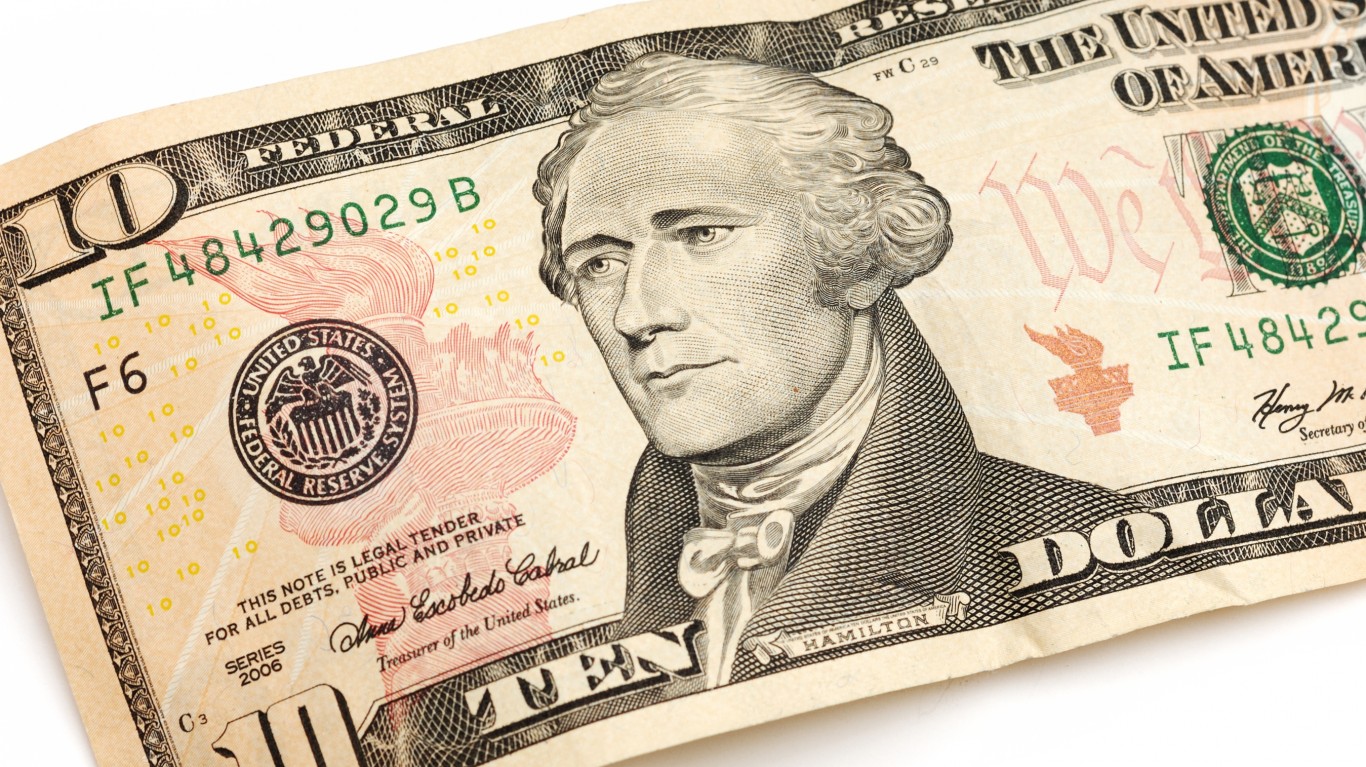 24/7 Wall St. reviewed how Americans spend money. One of the conclusions of this analysis is that consumer spending is relatively alive and well, despite the recession. This may mean that Americans continue to be over-leveraged. US citizens have, in general, brought down their indebtedness. However, holiday spending rose substantially from last year, and the extent to which Americans feel poor has declined now that the recession has ended. Americans spend about 15% of their household incomes on things that they do not need to satisfy their vices or to keep themselves amused.
24/7 Wall St. reviewed how Americans spend money. One of the conclusions of this analysis is that consumer spending is relatively alive and well, despite the recession. This may mean that Americans continue to be over-leveraged. US citizens have, in general, brought down their indebtedness. However, holiday spending rose substantially from last year, and the extent to which Americans feel poor has declined now that the recession has ended. Americans spend about 15% of their household incomes on things that they do not need to satisfy their vices or to keep themselves amused.
We examined the changes in spending patterns over the course of one generation–20 years. Americans have certainly not cut back on vices because of the recent difficult economy, with the exception of casinos which were hurt badly by the slowdown. Money spent on alcohol and tobacco is about the same as it was two decades ago. Sin apparently is not beaten down by hard times.
Data from the Bureau of Labor Statistics was one of the core sources of information for the 24/7 analysis. We looked spending habits in 1989 and then again in 2009. The average household expenditure two years ago was $49,000. That is measured against household income before taxes of about $63,000. Real incomes have not risen over the course of the last ten years, something that has not happened in any decade since the Depression. Over the course of the last two decades the increase in real income was only 10%.
The patterns of how people spend money on things has changed. People spend much more on television, radio, and sound systems than they did in 1989. They also spend more on pets and toys.
The BLS divides households into nine income groups. The lowest is households with income less than $5,000 a year. It is hard to imagine how such a household could exist. But, the government definition includes people who rent rooms or other living spaces, so in reality a college student or group of college students would qualify. The highest income group contains households with incomes of over $70,000 a year.
24/7 reviewed how American households spend their money and identified categories in which the expenditures are purely discretionary as a way to set its final list of ways people spend money on unnecessary items. We removed all expenses that could be considered essential to maintain a reasonable living, good health and a steady job. Then, we identified the ten categories of unnecessary purchases which accounted for the largest part of U.S. household expenditures. We also broke the data into several demographics, including income before taxes, regions of the country, and the number of people in each household.
The ten categories of unnecessary purchase can be balanced against the ability of Americans to save money or pay off debts. The “average” American household which has an income of $63,000 spends more than $8,000 on goods and services it does not actually need. The credit crisis might not have been so bad if all that money had been put into savings accounts between 1989 and 2009, but the period would not have been nearly as fun.
10. Apparel Products and Services
 > Annual Amount Spent Per Household: $249
> Annual Amount Spent Per Household: $249
> % of Total Annual Expenses: 0.5%
This category includes unnecessary purchases such as clothing rentals and storage, dry cleaning, jewelry, and watch repair. Clothing and shoe repairs, which are also included, are rarely considered a waste, but they account for a relatively modest portion of this category. The average amount spent per household is $249. This is slightly down from the 1989 amount, which was $266.
9. Tobacco
 > Annual Amount Spent Per Household: $380
> Annual Amount Spent Per Household: $380
> % of Total Annual Expenses: 0.8%
The average household spends more than $380 each year on tobacco products and smoking supplies, which includes cigarettes, cigars, pipes, and chewing tobacco. It is worth remembering that this average includes households where no one pays for tobacco products. Despite this fact, tobacco’s portion of the average household’s budget, 0.8%, is larger than what Americans spend on fresh fruit and milk combined. A person who smokes a pack of cigarettes a day in New York state will spend more than $4,000 a year, which is roughly 10% of the average American income before taxes.
8. Entertainment Equipment and Services, Nonessential
 > Annual Amount Spent Per Household: $400
> Annual Amount Spent Per Household: $400
> % of Total Annual Expenses: 0.8%
Products in this category include bicycles, trailers, camping equipment, hunting and fishing equipment, sports equipment, boats, photographic equipment and supplies. The average expenditures dedicated to items in this category among all households is $400. The greatest average amount, $870, occurs among households with a husband, wife, and an eldest child age 6 to 17 years. In households with only one parent and at least one child under 18, the amount drops to $188. In 1989, the average amount for all households was slightly less, at $369.
7. Alcohol
 > Annual Amount Spent Per Household: $435
> Annual Amount Spent Per Household: $435
> % of Total Annual Expenses: 0.9%
In 2009, the average American household spent $435 on beer, wine, hard liquor, and mixed drinks. This is more than the amount spent on all non-alcoholic beverages combined. Despite the higher prices often paid in restaurants and bars, the majority of money spent is on alcohol is for drinks consumed in the home. Households consisting only of a husband and wife spent an average of $582, roughly $400 more than single-parent households. On average, household spending on alcohol increased 35% from 1989, but the percent of their total budget spent on drinks is about the same: 1% in 1989 versus 0.9% in 2009.
6. Fees and Admissions
 > Annual Amount Spent Per Household: $628
> Annual Amount Spent Per Household: $628
> % of Total Annual Expenses: 1.3%
In 2009, the average household spent $628 on fees and admissions for sporting events, films, and concerts. This category also includes club memberships and movie rentals. These costs are more than what the average household spent on personal care products. People in the Northeast spent $780 on this category, about $370 more than those in the South. The average annual expenses for these products are nearly double what they were in 1989, when the average movie ticket cost $4, about half of what people spend today.
5. Lodging, Vacation Homes and Hotels
 > Annual Amount Spent Per Household: $672
> Annual Amount Spent Per Household: $672
> % of Total Annual Expenses: 1.4%
The average American household spent more than $670 on vacation homes and hotels. While this is more than the $485 spent twenty years ago, Americans are actually spending less than they used to on their total budgets – 1.7% in 1989 versus 1.4% in 2009. As might be expected, households which make more than $70,000 each year spent far more than the average American: $1,511 in 2009. Households in the Northeast spent $924 on vacation homes and hotels, nearly double what those in the South pay each year.
4. Pets, Toys, Hobbies, and Playground Equipment
 > Annual Amount Spent Per Household: $690
> Annual Amount Spent Per Household: $690
> % of Total Annual Expenses: 1.4%
The average household spent nearly $700 on pets, toys, hobbies, and playground equipment. Nearly 80% of the expenses in this category come from pets, including food and veterinary bills. In contrast, households only spent $140 on toys and games. Families with the oldest child under 6 only spent $670. Families with a child older than 18 spent nearly $1,200. Most of this difference comes from significantly more spending on veterinary services. Households in the Western United States spent $800 on pets, toys and games – 20% more than those in the Midwest. These expenses have increased from 0.9% of household budgets in 1989 to 1.4% in 2009.
3. Television, Radio, and Sound Equipment
 > Amount Spent Per Household: $975
> Amount Spent Per Household: $975
> % of Total Annual Expenses: 2%
In 2009, the average household spent $975 on television, radio, and sound equipment, including cable TV, video game hardware, and movie players. This amount is up from $429 in 1989. For comparison, the average amount spent on reading material, which is another household expenditure category, was only $109. The group which spent the greatest portion of their budget in this category, 2.5%, was those who made between $5,000 to $9,999. The group which spent the least was the group making the most. Households earning $70,000 or more spent only 1.7% of their budget on items in this category.
2. Gifts
 > Amount Spent Per Household: $1,067
> Amount Spent Per Household: $1,067
> % of Total Annual Expenses: 2.2%
Although Americans spend a great deal of money on unnecessary goods and services for themselves, they also spend a large amount on gifts for others. The average amount spent on gifts (including housing, apparel, and entertainment items) per household in 2009 was $1,067. This amount has increased from $887 in 2009. Households with incomes of less than $5,000 spent an average of $479, while households earning between $5,000 and $9,999 spent an average $261, the lowest amount.
Thank you for reading! Have some feedback for us?
Contact the 24/7 Wall St. editorial team.



